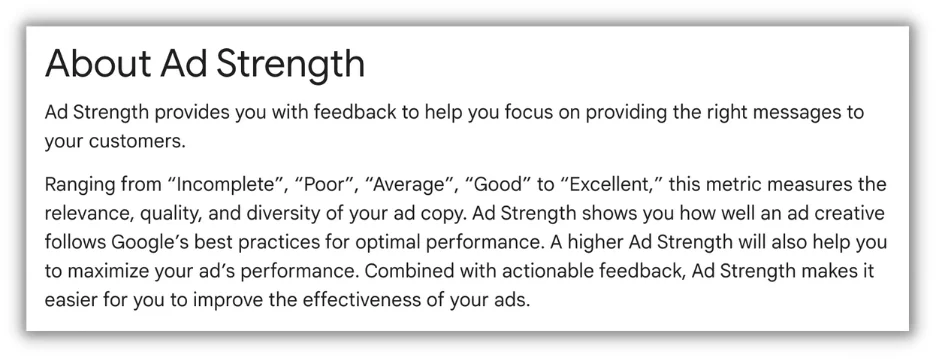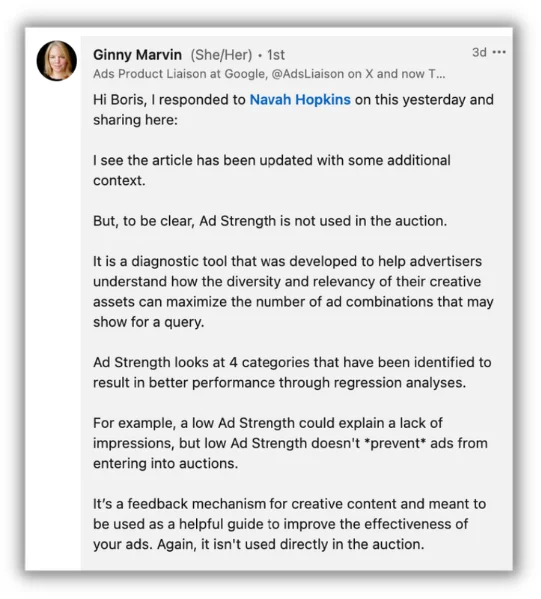Ad Strength is one of those metrics that ebbs and flows in importance. Right now, there’s been an uptick in conversations about Google’s Ad Strength metric. Those discussions were prompted by a recent press release from Google around some new features coming to the platform. These updates were mostly centered on updates coming to Performance Max capabilities using AI for text and imagery.
So we felt like now was a good time to dive into Google Ad Strength and discuss whether or not it actually matters—and how to improve it if it does.
Contents
What is Ad Strength?
Before we get into whether or not you should pay attention to Ad Strength, let’s talk about what it is.
Essentially, Ad Strength is meant to help advertisers develop strong ads that are more likely to perform well based on Google’s data, but is only used as an indicator, not an actual ranking.
In that way, it’s very similar to Quality Score or Optimization Score. Both are meant to help advertisers develop strong keyword lists and ad accounts, but aren’t actual dictators of how the account will do.
? Worried you’re wasting spend in Google Ads? Find out with a free, instant audit >> Google Ads Performance Grader
How does Ad Strength impact Google Ads?
Does not having the necessary quantity and variety of assets negatively impact your ad performance?
If you look at the definition of Ad Strength…


…it almost seems like it would have a negative impact. Specifically, the last two sentences calling out maximizing performance and the effectiveness of your ads.
But countless advertisers have had different experiences, many of them claiming that their Poor ads actually outperformed the Excellent or Good ads in their accounts.
Additionally, you may notice that ads with a Poor or Average Ad Strength don’t have as many impressions as those with Good or Excellent ratings.
So, does a low Ad Strength mean your ads are going to have their impressions throttled?
The short answer is no to both:
- Ad Strength will not impact the performance of your ads on Google.
- A low Ad Strength will not prevent your ads from showing on Google.
But here’s the thing…both of those things COULD happen IF you have low Ad Strength.
If your Ad Strength is low, you could see worse performance for those ads. Your ads also might not win many auctions if they have Poor Ad Strength.
Google has emphasized many times that Ad Strength is only an indication of how well your ad is constructed based on their internal best practices.
After some other articles were written, Ginny Marvin, Google’s Ad Liaison, responded with this message:


?? Is your Google Ads account set up for success? Download now >> The Last Guide to Google Ads Account Structure You’ll Ever Need
Recent updates that impact Ad Strength
As I mentioned, Google recently released some updates to its Google Ads platform that have put a spotlight on Ad Strength. You can read that article here and hear about how we think these changes lean into Google’s two main focuses for Performance Max updates here.
But one paragraph caught the eye of many advertisers and really started this whole Ad Strength discussion:


Google says that moving forward, the quantity and variety of assets will now play a larger role in your Ad Strength scores for your creatives. Basically, “since we’re making it easier for you to have these additional assets and variety, we’re going to start holding you accountable to these standards.”
For the most part, advertisers don’t have an issue with this…but with the actual impact of Ad Strength as a whole.
Should you pay attention to Ad Strength?
(I’ll start this section by saying that I’m writing this from my own personal experience as well as those that I’ve heard from others. I’d love to hear from anyone who disagrees with my approach or would tweak it based on your own experiences. The more points of view, the better.)
Now that you’re caught up on the recent discussions in the industry and I have my disclaimer out of the way, let’s focus on what actually matters for your day-to-day:
Should you pay attention to Ad Strength or not? If so, how should you pay attention to it?
My opinion: sometimes.
Your goal as a marketer should always be to create ads that are as relevant and meaningful as possible to your clients and their respective customers. If you’re doing this well, you’re likely going to hit most of the benchmarks for a high Ad Strength right out of the gate. And that applies for all ad formats.
? Want to learn more about search engine marketing on Google? Get the free guide >> PPC 101: Complete Guide to Google Ads
How can you improve Ad Strength?
Here are a few high-level suggestions for best practices with ads:
- Create compelling messaging that highlights the business’s strengths.
- Answer the customer’s query or relate the ads to the content they’re viewing (if possible), i.e. include keywords or something relevant to your targeting.
- Test different variants of your messaging. You never know what will work best.
- Leverage all the bells and whistles you can including images, videos, logos, locations, ad assets, etc.
While those have been many of the ad copywriting best practices (in my mind) for a long time, it’s not as obvious that they’re tied to Ad Strength as well.
Whether it’s the Ad Strength indicators for Responsive Search Ads:


Or the different ratings you can achieve with Performance Max:


Those best practices get you most of the way there. Your job is to then monitor your ad performance and determine if you need to make adjustments.
If you’re seeing good performance from your ads and you’re happy with everything, you might not care what your Ad Strength is.
If you’re not getting the results you need, maybe look at the Ad Strength Improvements column and see what guidance Google gives.
You can even take it one step further. Click to edit the ad and see what suggestions Google has for you on each of the suggested areas for improvement. I have it blurred out below, but there are a handful of new headlines suggested for this ad variant that Google thinks could be better. Maybe they work, maybe they don’t, but I at least have some new ideas that I didn’t have to think of on my own.


For Performance Max, you can now create all sorts of new assets directly in the editor without much work. There’s almost no excuse for not having more ad assets to help you level up your score.


Don’t make Ad Strength your campaign’s weakness
As a reminder to close this out, don’t optimize to Ad Strength just because Google promotes it. Don’t forget, Ad Strength is not your KPI. Focus on your business KPIs and use Ad Strength as you need to maybe make some improvements.
Need help with your Google Ads campaigns? Find out how we can help.